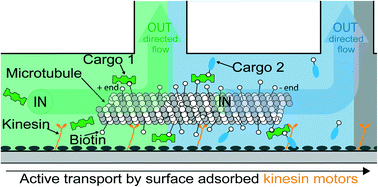Nanoshuttles propelled by motor proteins sequentially assemble molecular cargo in a microfluidic device†
Abstract
Nanoshuttles powered by the molecular motor kinesin have the potential to capture and concentrate rare molecules from solution as well as to transport, sort and assemble them in a high-throughput manner. One long-thought-of goal has been the realisation of a molecular assembly line with nanoshuttles as workhorses. To harness them for this purpose might allow the community to engineer novel materials and nanodevices. The central milestone towards this goal is to expose nanoshuttles to a series of different molecules or building blocks and load them sequentially to build hierarchical structures, macromolecules or materials. Here, we addressed this challenge by exploiting the synergy of two so far mostly complementary techniques, nanoshuttle-mediated active transport and pressure-driven passive transport, integrated into a single microfluidic device to demonstrate the realisation of a molecular assembly line. Multiple step protocols can thus be miniaturised to a highly parallelised and autonomous working lab-on-a-chip: in each reaction chamber, analytes or building blocks are captured from solution and are then transported by nanoshuttles across fluid flow boundaries in the next chamber. Cargo can thus be assembled, modified, analysed and eventually unloaded in a procedure that requires only one step by its operator.


 Please wait while we load your content...
Please wait while we load your content...